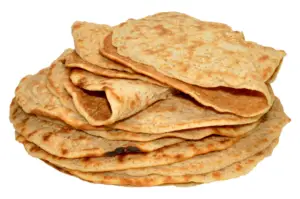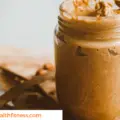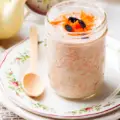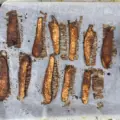Are you craving a hearty and flavorful breakfast option? Look no further than Staffordshire oatcakes! These delicious and nutritious treats are a staple in the Staffordshire region of England. In this ultimate guide, we’ll take you through the step-by-step process of making these mouthwatering oatcakes. From the history and ingredients to the cooking techniques and serving suggestions, we’ve got you covered.
Staffordshire oatcakes are a delightful combination of oats, flour, and yeast, resulting in a thin and savory pancake-like treat. They are a beloved dish in Staffordshire, England, and are often enjoyed as a hearty breakfast or brunch option. With their crispy exterior and soft, chewy interior, Staffordshire oatcakes are sure to please even the pickiest of eaters.
In this comprehensive guide, we will walk you through the process of making Staffordshire oatcakes from scratch. We’ll cover everything from the history of these delectable treats to the best ways to serve and store them. So, let’s dive in and discover the secrets to making the perfect Staffordshire oatcakes!
The History of Staffordshire Oatcakes
Staffordshire oatcakes have a rich history that dates back centuries. These oatcakes have been a staple in Staffordshire since the 17th century and were originally known as “pewter” or “peyter” pancakes. The name “oatcakes” emerged later as the primary ingredient shifted from wheat flour to oats.
Traditionally, Staffordshire oatcakes were made by local women known as “oatcake ladies.” They would sell their freshly made oatcakes from portable ovens, known as “baker’s lads,” on the streets of Staffordshire. Today, these oatcakes are still a popular choice among locals and visitors alike, and the tradition of making them by hand continues.
Ingredients You’ll Need
For the Oatcakes:
- 1 cup fine oatmeal (oat flour)
- 1/2 cup all-purpose flour
- 1 teaspoon active dry yeast
- 1/2 teaspoon sugar
- 1/2 teaspoon salt
- 1 1/4 cups lukewarm water
- Butter or oil for cooking
For Serving (Fillings and Toppings):
- Grated cheese (Cheddar is traditional)
- Cooked bacon or sausage
- Sautéed mushrooms
- Fried egg
- Tomato slices
- Optional: brown sauce, ketchup, or other condiments
Staffordshire Oatcakes Recipe
Step 1: Prepare the Batter
In a bowl, mix the oatmeal, all-purpose flour, sugar, and salt.
Dissolve the yeast in lukewarm water and let it sit for a few minutes until frothy.
Gradually add the yeast mixture to the dry ingredients, stirring well to create a smooth batter. Cover the bowl with a clean cloth and let it rest in a warm place for about an hour. The batter should rise and become bubbly.
Step 2: Cook the Oatcakes
Heat a non-stick skillet or griddle over medium heat. Lightly grease it with butter or oil.
Give the batter a good stir. It should have a thick, pourable consistency. If it’s too thick, you can thin it out with a bit of water.
Pour a ladleful of the batter onto the skillet and spread it out into a thin, round pancake using the back of the ladle. The oatcake should be about 8-10 inches in diameter.
Step 3: Cook Both Sides
Cook the oatcake for 2-3 minutes on one side until small bubbles form on the surface and the bottom is golden brown.
Flip the oatcake and cook for an additional 2-3 minutes on the other side until golden brown.
Step 4: Serve
Once cooked, place the oatcake on a plate.
While still warm, sprinkle a generous amount of grated cheese on one half of the oatcake.
Add your choice of fillings such as cooked bacon, sausage, sautéed mushrooms, and a fried egg.
Fold the other half of the oatcake over to cover the fillings, creating a half-moon shape.
Serving Suggestions
Now that your oatcakes are cooked to perfection, it’s time to decide how you want to enjoy them. Staffordshire oatcakes are incredibly versatile and can be filled with a variety of delicious ingredients. Here are some traditional and creative serving suggestions:
Traditional Fillings
- Bacon and Cheese: Fill your oatcakes with crispy bacon and a generous sprinkling of grated cheese.
- Cheese and Tomato: Add sliced tomatoes and your favorite cheese for a classic combination.
- Cheese and Mushroom: Sauteed mushrooms and melted cheese make for a savory and satisfying filling.
- Cheese and Onion: Mix grated cheese with caramelized onions for a flavor-packed filling.
Sweet and Savory Variations
- Sweet Oatcakes: Serve the oatcakes with a drizzle of honey or maple syrup and a sprinkle of cinnamon or powdered sugar. You can also add fresh fruit or jams for a fruity twist.
- Breakfast Burrito: Fill the oatcakes with scrambled eggs, sausage, and your favorite vegetables for a hearty breakfast burrito.
- Smoked Salmon and Cream Cheese: Spread cream cheese on the oatcakes and top with smoked salmon, capers, and fresh dill for an elegant and delicious option.
Feel free to get creative and experiment with your favorite fillings. The possibilities are endless!
Storage and Reheating
If you have leftover oatcakes or want to make a bigger batch for later use, here’s how you can store and reheat them:
Freezing Instructions
- Allow the cooked oatcakes to cool completely.
- Place them in a freezer-safe container or bag, separating each oatcake with parchment paper to prevent sticking.
- Label the container with the date and contents.
- Freeze the oatcakes for up to 3 months.
Reheating Methods
- Oven: Preheat your oven to 350°F (175°C). Place the frozen oatcakes on a baking sheet and bake for 10-15 minutes, or until heated through.
- Skillet: Heat a skillet over medium heat and add a small amount of oil or butter. Cook the frozen oatcakes for 3-4 minutes per side, or until heated through.
- Toaster: If your oatcakes are thin enough, you can toast them in a toaster until they are warm and crispy.
FAQs
Can I use gluten-free flour?
Yes, you can use gluten-free oat flour or a gluten-free flour blend to make gluten-free Staffordshire oatcakes. Just make sure all the other ingredients you use are also gluten-free.
Can I make oatcakes without yeast?
While yeast is traditionally used in Staffordshire oatcakes, you can make a yeast-free version by omitting the yeast and reducing the amount of liquid slightly. The texture may be slightly different, but they will still be delicious.
Can I make mini oatcakes?
Absolutely! If you prefer smaller oatcakes, simply reduce the amount of batter you spoon onto the pan. Adjust the cooking time accordingly to ensure they are cooked through.
Can I substitute milk with a plant-based alternative?
Yes, you can use your favorite plant-based milk, such as almond milk or oat milk, as a substitute for cow’s milk in the oatcake batter. The taste and texture may vary slightly, but the end result will still be delicious.
9. Tips and Tricks for Perfect Oatcakes
Making the perfect Staffordshire oatcakes takes practice, but these tips and tricks will help you along the way:
- Adjusting the Thickness: If you prefer thicker oatcakes, spoon a larger amount of batter onto the pan. For thinner oatcakes, use less batter and spread it out more.
- Experimenting with Flavors: Add herbs, spices, or grated cheese to the batter for an extra burst of flavor. Get creative and make the oatcakes your own.
- Getting the Flipping Technique Right: Use a thin spatula or fish slice to carefully flip the oatcakes. Practice makes perfect, so don’t worry if your first few attempts are not picture-perfect.




